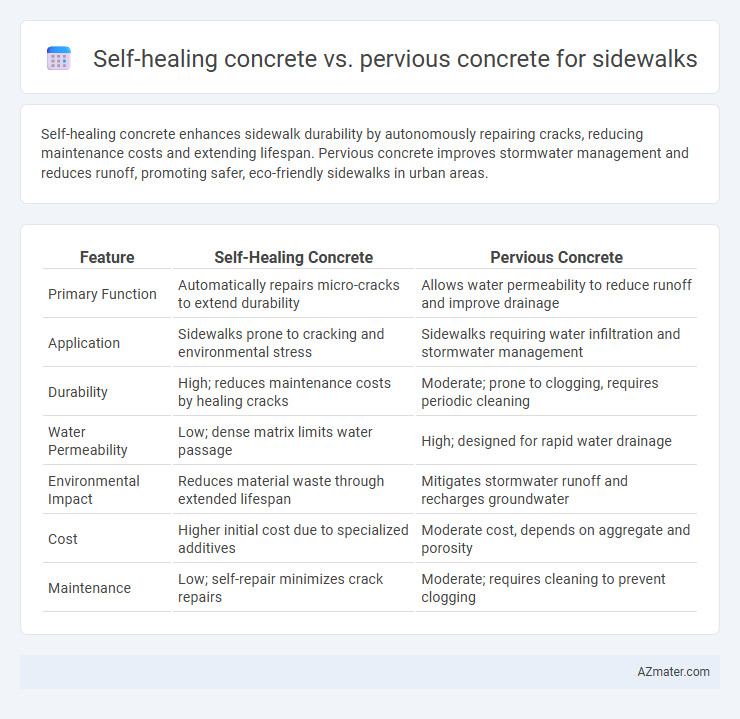Self-healing concrete enhances sidewalk durability by autonomously repairing cracks, reducing maintenance costs and extending lifespan. Pervious concrete improves stormwater management and reduces runoff, promoting safer, eco-friendly sidewalks in urban areas.
Table of Comparison
| Feature | Self-Healing Concrete | Pervious Concrete |
|---|---|---|
| Primary Function | Automatically repairs micro-cracks to extend durability | Allows water permeability to reduce runoff and improve drainage |
| Application | Sidewalks prone to cracking and environmental stress | Sidewalks requiring water infiltration and stormwater management |
| Durability | High; reduces maintenance costs by healing cracks | Moderate; prone to clogging, requires periodic cleaning |
| Water Permeability | Low; dense matrix limits water passage | High; designed for rapid water drainage |
| Environmental Impact | Reduces material waste through extended lifespan | Mitigates stormwater runoff and recharges groundwater |
| Cost | Higher initial cost due to specialized additives | Moderate cost, depends on aggregate and porosity |
| Maintenance | Low; self-repair minimizes crack repairs | Moderate; requires cleaning to prevent clogging |
Introduction to Innovative Concrete Technologies
Self-healing concrete incorporates microcapsules or bacteria that activate to repair cracks, significantly extending the lifespan of sidewalks by preventing water infiltration and structural damage. Pervious concrete features a porous structure that allows water to pass through, reducing surface runoff and improving stormwater management in urban environments. Both innovative concrete technologies enhance durability and sustainability, offering tailored solutions for resilient and eco-friendly sidewalk construction.
Overview of Self-Healing Concrete
Self-healing concrete incorporates innovative materials like microcapsules or bacteria that trigger repair processes when cracks form, enhancing durability and reducing maintenance costs in sidewalks. Its ability to autonomously seal fractures improves longevity and resistance to water infiltration compared to traditional concrete types. This advanced technology offers a sustainable solution by minimizing structural deterioration and environmental impact for urban pavement applications.
What is Pervious Concrete?
Pervious concrete is a highly porous material designed to allow water to pass through its surface, reducing stormwater runoff and promoting groundwater recharge. This type of concrete is ideal for sidewalks because it minimizes puddling and enhances environmental sustainability by managing rainwater naturally. Unlike self-healing concrete, which focuses on repairing cracks autonomously, pervious concrete primarily aims to improve drainage and reduce urban flooding.
Key Material Differences
Self-healing concrete incorporates microcapsules or bacteria that activate to seal cracks autonomously, enhancing durability and lifespan, whereas pervious concrete features a porous structure designed to allow water infiltration, reducing runoff and improving drainage. Self-healing concrete typically uses a dense cement matrix with healing agents embedded, while pervious concrete relies on larger aggregate sizes and reduced fine material to maintain permeability. Material composition differences significantly affect their mechanical properties and suitability for sidewalk applications, with self-healing concrete prioritizing longevity and crack resistance, and pervious concrete emphasizing environmental benefits and stormwater management.
Durability and Longevity Comparison
Self-healing concrete enhances sidewalk durability by autonomously repairing micro-cracks through embedded bacteria or polymers, significantly extending service life and reducing maintenance costs. Pervious concrete prioritizes permeability, allowing water drainage but generally exhibits lower tensile strength and faster surface wear under heavy traffic, potentially decreasing longevity compared to self-healing variants. Evaluations indicate self-healing concrete outperforms pervious concrete in resisting environmental stressors, making it a superior choice for long-term sidewalk applications where durability is critical.
Water Management Capabilities
Self-healing concrete enhances water management in sidewalks by automatically sealing cracks, preventing water infiltration that can cause structural damage and reduce runoff contamination. Pervious concrete improves water management by allowing rainwater to permeate through the pavement, reducing surface runoff and promoting groundwater recharge. While self-healing concrete focuses on durability and preventing water intrusion, pervious concrete prioritizes efficient stormwater drainage and sustainable water flow management.
Environmental Impact Assessment
Self-healing concrete reduces maintenance frequency by autonomously repairing cracks, lowering resource consumption and waste generation compared to traditional materials, which enhances sustainability in sidewalk construction. Pervious concrete improves stormwater management by allowing water infiltration, reducing runoff and mitigating urban heat island effects, which benefits local ecosystems and groundwater recharge. Evaluating lifecycle environmental impacts, self-healing concrete offers advantages in durability and carbon footprint reduction, while pervious concrete excels in managing water quality and promoting green infrastructure.
Installation and Maintenance Considerations
Self-healing concrete requires specialized installation techniques involving embedded microcapsules or bacteria that activate upon crack formation, reducing long-term maintenance needs by autonomously repairing damage. Pervious concrete installation demands precise control over aggregate grading and compaction to ensure optimal permeability, with routine maintenance focused on preventing clogging through regular vacuuming or pressure washing. While self-healing concrete offers superior durability with minimal upkeep, pervious concrete requires more frequent maintenance to maintain its drainage properties, influencing overall lifecycle cost and performance on sidewalks.
Cost Analysis: Self-Healing vs Pervious Concrete
Self-healing concrete typically incurs higher initial costs due to advanced materials and technology used for crack repair, but it reduces long-term maintenance expenses by autonomously addressing structural damage. Pervious concrete offers lower upfront installation costs and provides excellent stormwater management benefits, yet may require more frequent repairs and replacement due to susceptibility to clogging and wear. When analyzing total lifecycle costs, self-healing concrete demonstrates potential savings over time despite higher starting investments, while pervious concrete remains cost-effective primarily in applications emphasizing permeability and water drainage.
Best Applications for Sidewalk Projects
Self-healing concrete is ideal for sidewalks in areas prone to cracking from freeze-thaw cycles, as its microcapsules release healing agents that repair damage, extending pavement lifespan and reducing maintenance costs. Pervious concrete excels in sidewalk projects requiring efficient stormwater management, allowing water to filter through and reduce runoff, thus preventing pooling and improving safety. Selecting between these materials depends on environmental conditions: self-healing concrete suits durability-focused urban sidewalks, while pervious concrete is preferred for sustainable, eco-friendly designs in regions with heavy rainfall.

Infographic: Self-healing concrete vs Pervious concrete for Sidewalk
 azmater.com
azmater.com